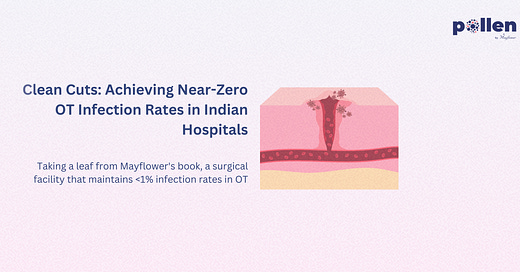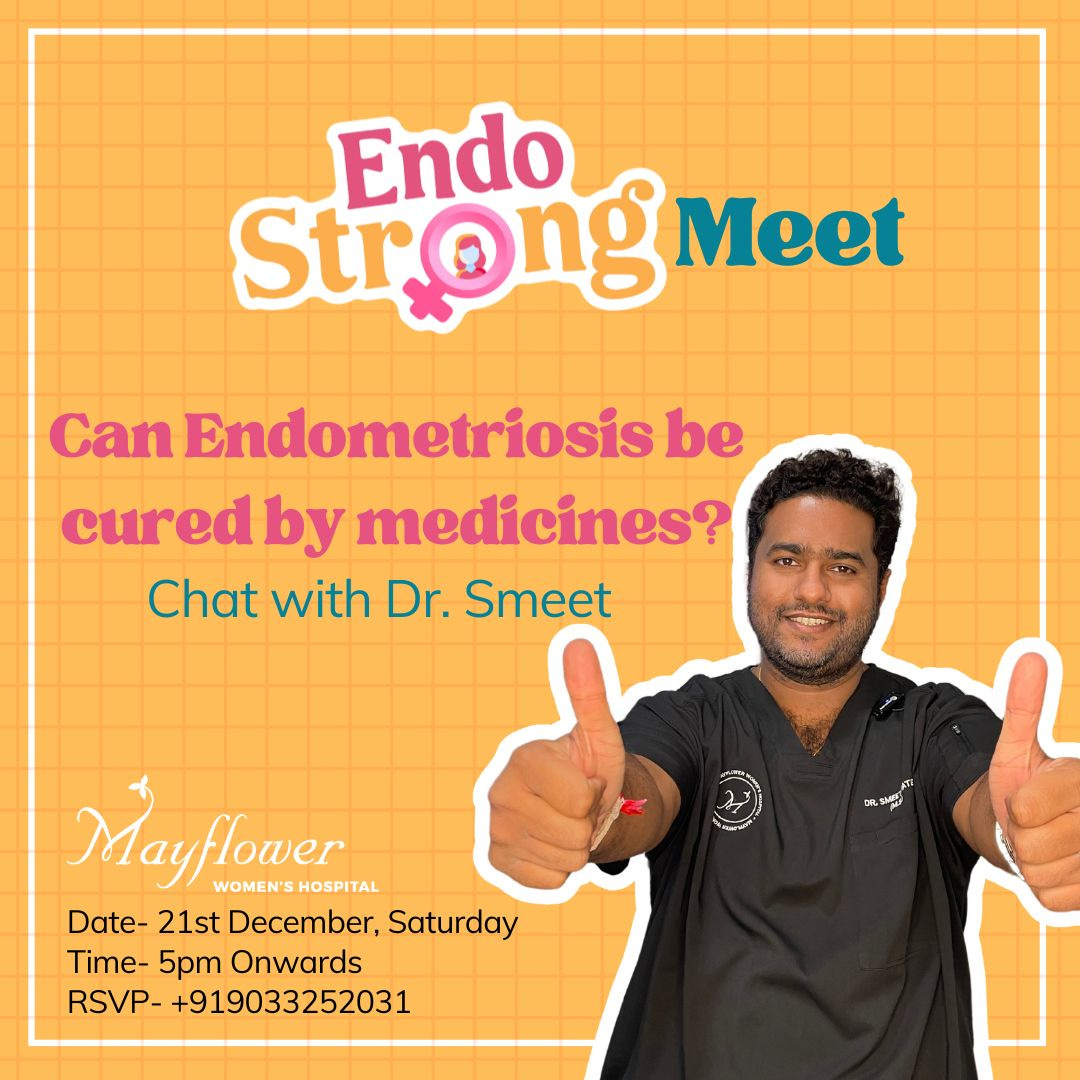Clean Cuts: Achieving Near-Zero OT Infection Rates in Indian Hospitals
Taking a leaf from Mayflower's book, a surgical facility that maintains <1% infection rates in OT
Surgical site infections (SSIs) remain a persistent challenge in healthcare, accounting for up to 38% of nosocomial infections among surgical patients in India. For healthcare practitioners, these infections are a significant contributor to patient morbidity, prolonged hospital stays, and reputational challenges for hospitals and surgeons alike.
While surgical site infections (SSIs) can seem like an inevitable risk, our experience at Mayflower Hospital proves otherwise. For over two decades, we’ve consistently maintained near-zero infection rates in our operating theatres. As a leading women’s hospital, we take immense pride in setting a benchmark for exemplary standards in surgical care.
This success isn’t the result of a single initiative or one-off measures—it’s the outcome of meticulously designed protocols, cutting-edge technology, and a deeply ingrained culture of infection control that every member of our team embraces.
In this newsletter, we’d like to share what has worked for us and how these practices can inspire and guide you toward achieving similar outcomes.
What does the landscape look like?
India performs around 2.5 crore surgeries annually, covering everything from cesarean sections to complex orthopedic and cancer-related procedures. Yet, infection control standards vary significantly across the country.
Data suggests that SSI rates in India can range from 6% in well-equipped urban hospitals to over 30% in resource-limited settings. The cost of these infections is high, both financially and clinically. Each SSI can extend a patient’s hospital stay by 7–10 days, doubling treatment costs and increasing the risk of mortality by up to 11 times compared to patients without infections.
Things we learnt and got better at over the past few decades
At Mayflower Hospital, infection control isn’t viewed as a set of isolated tasks—it’s integrated into every aspect of surgical care. Here’s a closer look at the measures that have helped them achieve near-zero infection rates:
Class 100 Operating Theatres
The hospital’s operating theatres are built to maintain “Class 100” air quality standards, with fewer than 100 particles per cubic foot of air. This is achieved through HEPA filters and positive-pressure ventilation systems, which prevent contaminants from entering the sterile environment. Such systems drastically reduce the airborne pathogens that are a common source of SSIs.Plasma Sterilization
For instrument sterilization, Mayflower employs advanced plasma sterilization. This technique uses hydrogen peroxide gas plasma to destroy microorganisms without leaving harmful residues, making it particularly effective for delicate, heat-sensitive surgical tools. This ensures instruments remain sterile and safe for use, every time.Team Training and Adherence to Protocols
Mayflower’s staff are rigorously trained in infection control practices, including the WHO Surgical Safety Checklist. From preoperative patient preparation to postoperative wound care, every step is standardized and audited regularly.Attention to Detail
Small but critical measures, like monitoring hand hygiene compliance, limiting traffic in operating theatres, and ensuring strict zoning between sterile and non-sterile areas, are rigorously enforced. These practices collectively minimize contamination risks.
What can be done?
For many hospitals, replicating Mayflower’s standards might seem daunting, especially in resource-constrained settings. However, many of these measures are scalable and adaptable.
Ventilation Improvements: While Class 100 standards might not be feasible for all, even basic improvements like increasing air exchanges and installing HEPA filters can reduce airborne pathogen load significantly.
Standardized Sterilization: Plasma sterilization may represent the gold standard, but conventional methods like autoclaving can be optimized with proper training and monitoring.
Pre- and Post-Surgical Protocols: Simple measures like preoperative antiseptic skin preparation and timely antibiotic prophylaxis (administered within one hour of incision) have been shown to significantly lower SSI rates.
Right, but does it work?
Studies highlight the potential impact of consistent infection control practices:
Laminar airflow systems have reduced infection rates by up to 50% in some studies.
Administering prophylactic antibiotics within the right time window can reduce SSI risk by 30–45%.
Regular use of checklists, like the WHO Surgical Safety Checklist, has cut complication rates by as much as 33% in both developed and developing settings.
These figures represent practical, achievable outcomes when the right systems are in place.
Cleaner surgical future
The fight against SSIs is as much about mindset as it is about resources.
Hospitals across India, regardless of size, can take a leaf from Mayflower’s playbook. Start by addressing the basics: improve air quality in OTs, ensure instruments are sterilized effectively, and establish a culture of accountability among staff. Over time, these incremental changes can lead to significant reductions in infection rates.
For gynaecologists and surgeons, the stakes are particularly high. Procedures like cesarean sections and laparoscopic surgeries often involve vulnerable patients, making infection control even more critical.
P.S. Have a question or need specific resources? Write to us at publications@mayflowerhospital.com. We always love hearing from our readers.
Mayflower Endometriosis Clinic UPDATE — EndoStrong Meet 2.0
Every 2-3 months, we at Mayflower host the “EndoStrong Meet” at our Endometriosis Clinic—a welcoming, in-person event where individuals living with endometriosis and their allies can connect with each other and leading experts. It’s a safe and supportive space to share experiences and gain valuable insights.
This time, we’re excited to feature a special talk by Dr. Smeet Patel, our Endometriosis Specialist, who will dive into what it truly means to live with endometriosis and explore the most effective protocols for managing the condition.
If you’re in Ahmedabad, we’d love for you to share this invite with your endo patients and their families—everyone is welcome!
🗓 21st December. 2024, SATURDAY
🕑 5pm-7pm
🧧 Fee- FREE/-
📍Mayflower Women’s Hospital, Helmet Circle, Drive In Road. 380052.
ENDOMETRIOSIS WEEKLY UPDATE — Far up the Food Chain: Endo involvement around the Ileocecal Junction
Did you know that GI tract involvement in endometriosis, especially at the ileocecal junction, is more common than it seems?
In today’s edition, we delve into the numbers, the symptoms, and the critical role of GI surgeons in addressing this challenging condition.
Thanks for reading Pollen by Mayflower! If you liked what you read and would like to read more of it, please subscribe and receive regular updates from Mayflower.
And if you think a friend would love to read this, feel free to share it with them too. We’d appreciate it :)









